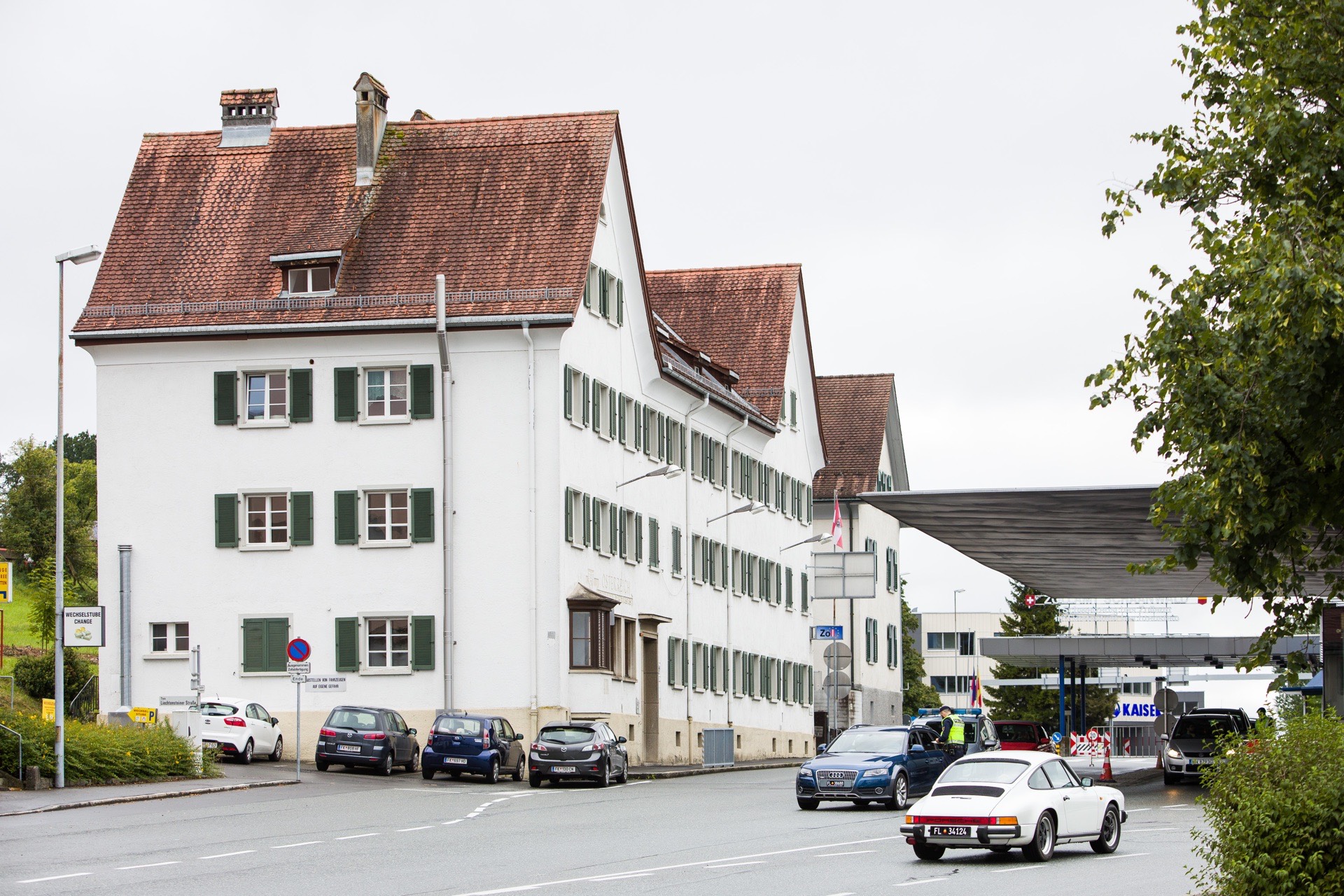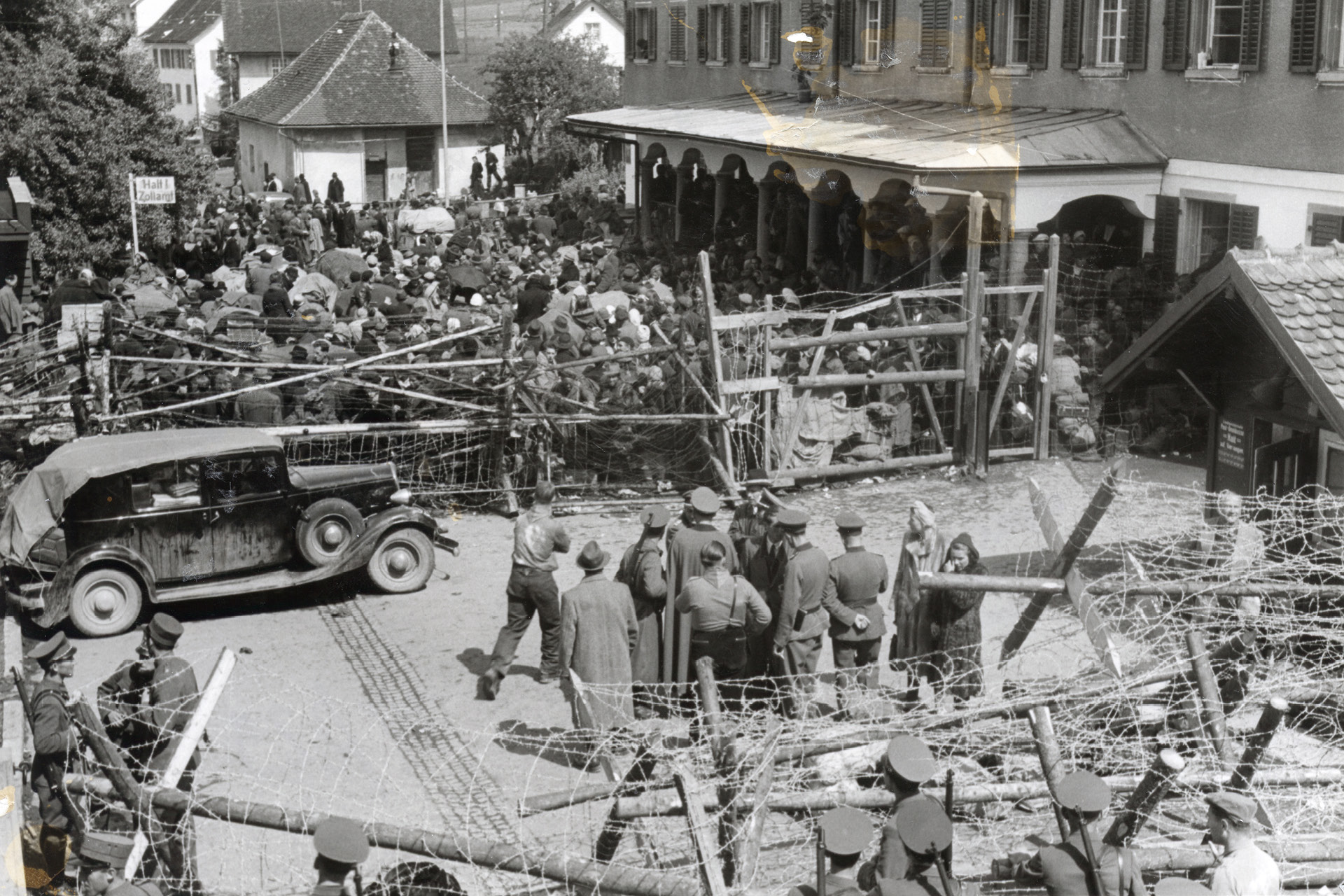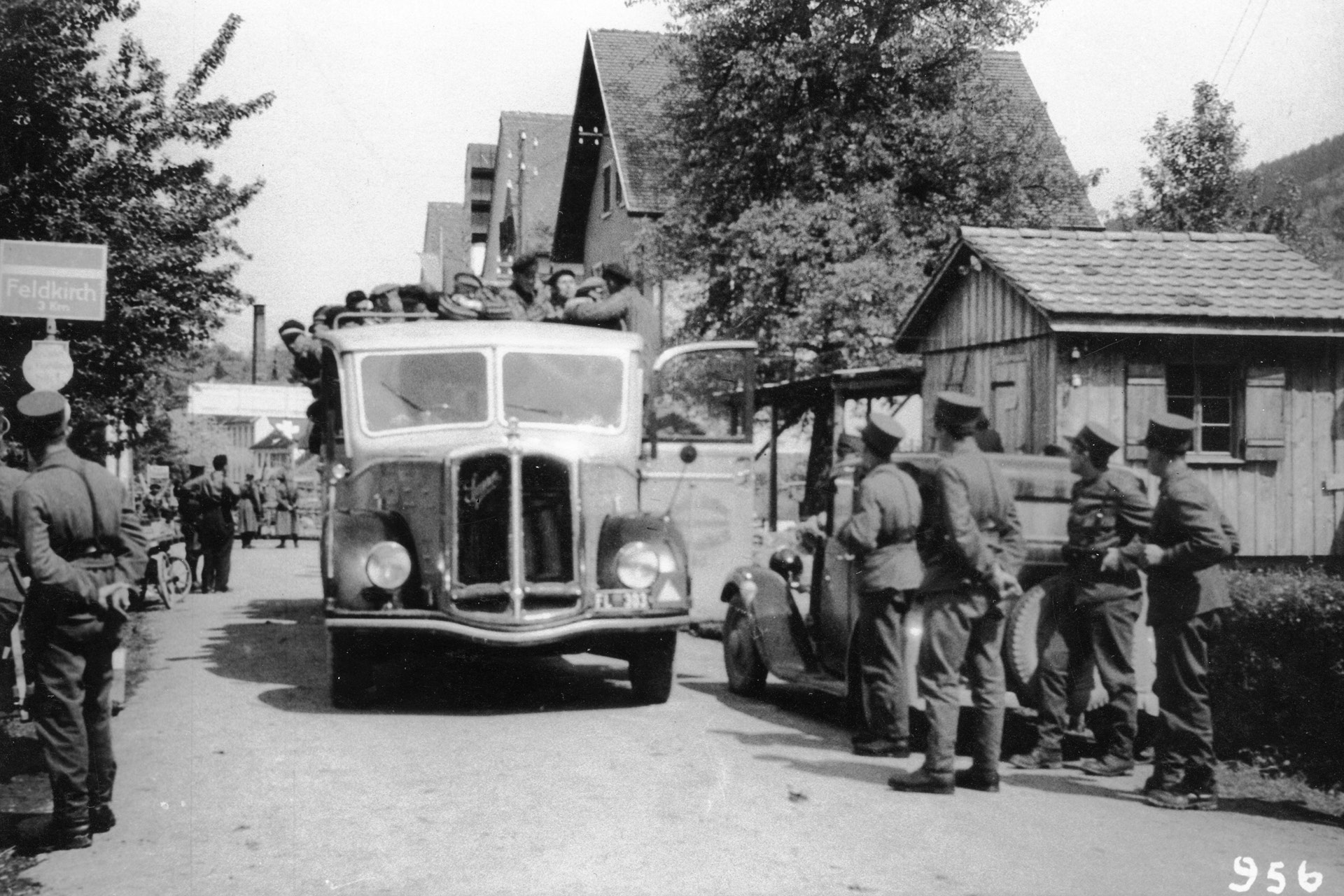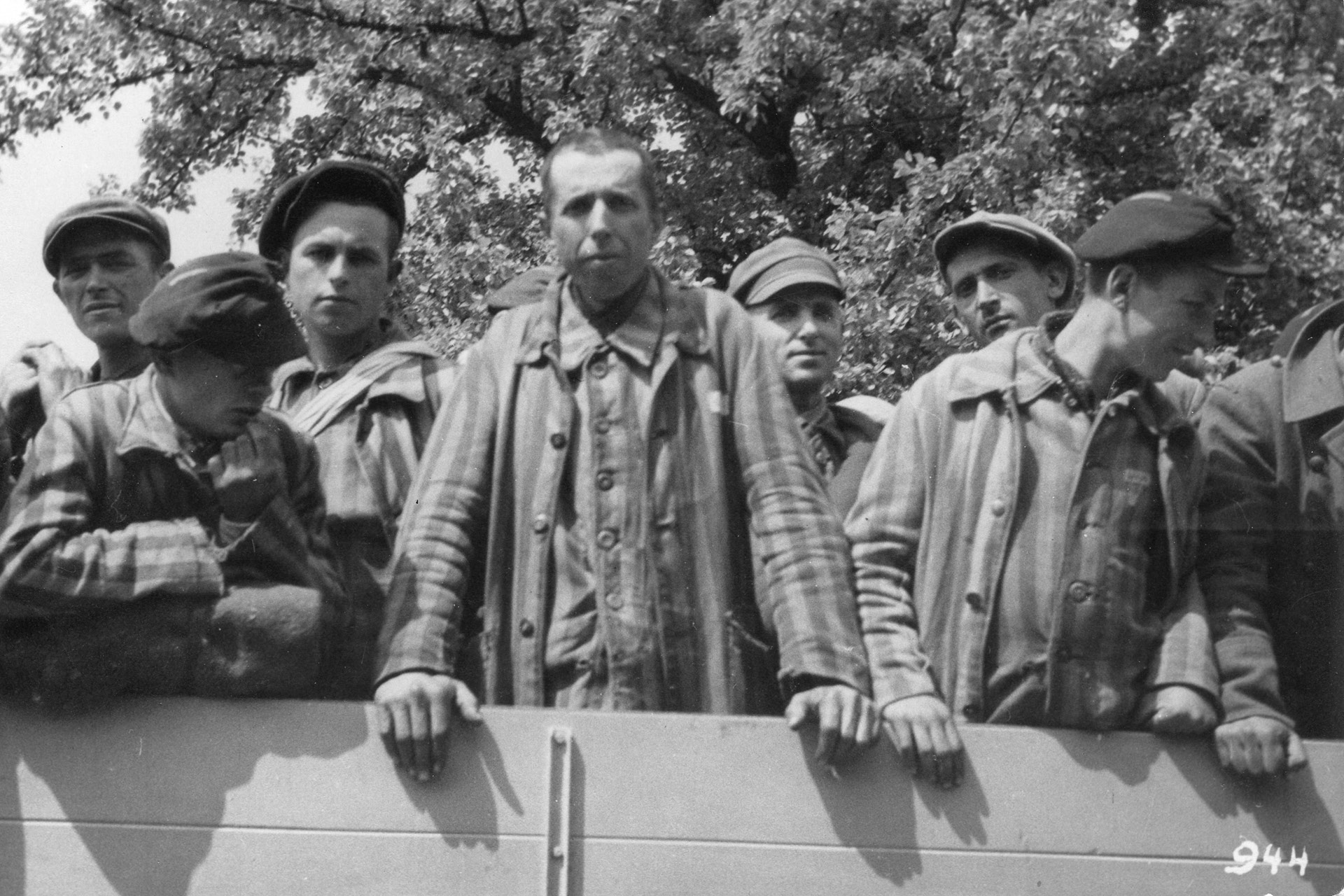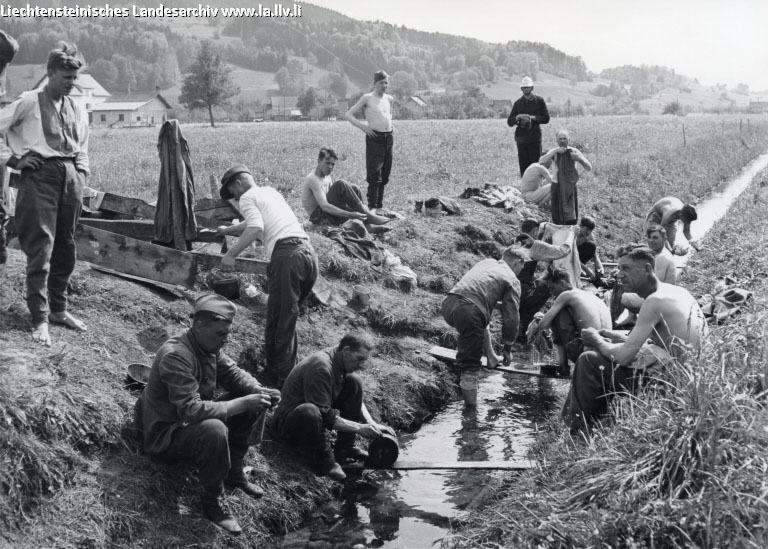End of the war> April 25 - May 2 1945
38 End of the war
Mass rush at the Liechtenstein border in the last days of the war
Tisis-Schaanwald, Nofels-Oberfresch, April 25 to May 2, 1945
In the last few days of the war, thousands of “foreign workers”, prisoners of war and forced laborers held in Vorarlberg try to escape – or are pushed over the border to get rid of them. On April 22, the Swiss Federal Council closes the eastern border. Only two crossings remain open. In addition to St. Margrethen, the border crossing from Feldkirch to Liechtenstein between Tisis and Schaanwald now becomes the eye of the needle for people trying to reach safety in the chaos of the last days of the war.
Between April 25 and May 2, 7,370 people crossed the border here alone, among them 3,424 French, 1234 Russians, 759 Poles, about 300 Dutch, and some Greeks and Italians. But also 156 Swiss and 123 Liechtensteiner flee from the approaching war. The largest number of people, almost 3,000, arrive at the Liechtenstein border on May 2. On this day, French units, which had taken Bregenz the day before, fight their way through Hohenems and Götzis in the direction of Feldkirch.
At the Tisis border crossing, crowds of people jam together, break through the barriers and now stand in front of the Swiss border guards. But the Swiss insist on checks. Among the fugitives are also undesirables, members of the Vichy government and Vorarlberg National Socialists, in whose cars larger assets are suspected.[1]
The short-term care of thousands of refugees is new territory for the Principality of Liechtenstein. In previous years, the government granted asylum to only a few people. Some Jewish refugees from the German Reich had been accepted if they had sufficient funds and guaranteed job creation through their economic activities. In addition, the principality had issued passports against payment to some persecuted Jews who tried to flee the German Reich to other countries. However, they did so only on condition that they would not make use of them to emigrate to Liechtenstein themselves.
Spontaneous support from individual Liechtenstein citizens and organized illegal escape assistance from smugglers in Feldkirch and Liechtenstein, however, made it possible for some Jewish refugees to get through Liechtenstein to Switzerland in 1938 and 39.
Some of them were picked up by the cantonal police in Buchs and sent back to the German Reich.
But now, at the end of the war, the events come thick and fast, and the images of helping scouts and Princess Gina rushing to the border are imprinted in the memory.
In the night of May 2 to 3, there is also another mass rush at the small border post Oberfresch between Nofels and Schellenberg. These are members of the so-called “Russian National Army” who fought against the Soviet Union under the command of the German Wehrmacht - and now seek safety from the Allies. In the last days of the war, the remnants of this army, a convoy of 494 people, including 33 women and 2 children, reach the border at Nofels. They fear that they will be forcibly sent back to the Soviet Union.
Paul Keel, border guard at this post, later recalls:
“And there was a gate here in 1945 in May, with barbed wire, and in the night when the Russians came, about 11:30 p.m., the gate was opened for them and then they ran up, in the direction of Schellenberg. They had horses and wagons, children and strangers with them, who did not belong to the actual troops, under General Holmston. (...)
Two of our comrades kept watch there, and when the Russians drove up, the first ones in cars, the ones in the rear on foot, they - they did not react to calls from the guard, and then Corporal Morff fired a shot at the first car. Then they kept still, and the adjudant got out and said ‘please don't shoot, the general is sitting in the next car’. On the basis of this, they then ceased firing, and the entire convoy then moved on up to, shortly after the Lion inn, they then surrendered their weapons.”[2]
The Russians were initially interned in Liechtenstein. But the principality government wants to get rid of them as soon as possible. And pressure is exerted by the Soviet Union. The majority of the Russians actually return to the Soviet Union in the summer, partly via the intermediate station of French internment in Vorarlberg. A Soviet repatriation commission gives them assurances. But most of them are sent to prison camps in their homeland.
About 130 of them, including their general, Count Boris Smyslovsky, alias Arthur Holmston, successfully refuse and are eventually not extradited either. They emigrate to other Western countries, especially Argentina.[3]
[1] See Ursina Jud, Liechtenstein und die Flüchtlinge zur Zeit des Nationalsozialismus : innen- und aussenpolitische Dimensionen der Flüchtlingspolitik eines Kleinstaates. Dissertation, Zurich 2007, p. 106-107. (https://www.zora.uzh.ch/id/eprint/163655/1/20080219.pdf, 12.3.2022)
[3] Peter Geiger, „Russische Nationalarmee“, entry in: Historisches Lexikon des Fürstentum Liechtenstein online (https://historisches-lexikon.li/Russische_Nationalarmee, 12.3.2022)
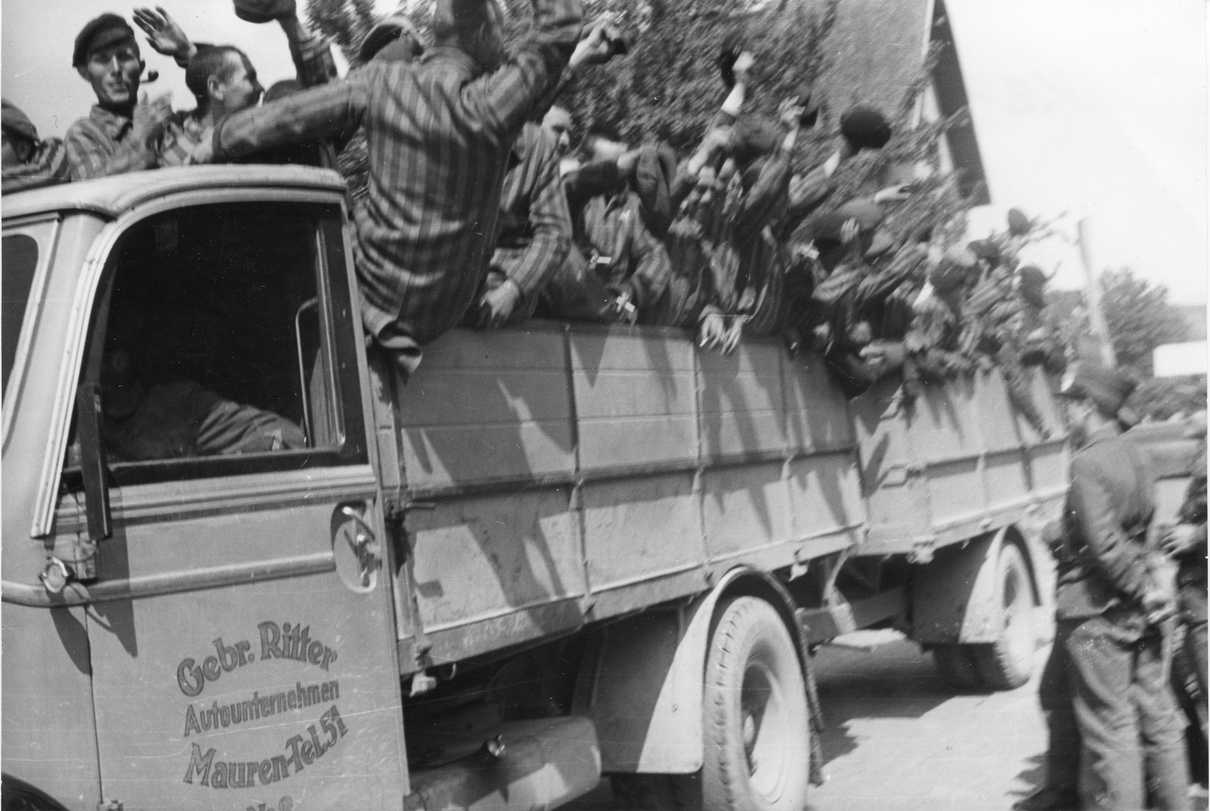
Surviving prisoners from Dachau on arrival in Mauren, May 1945
Liechtensteinisches Landesarchiv, B_413_005_004
Interned members of the "Russian National Army" washing clothes near Ruggell
Liechtensteinisches Landesarchiv, B 413_002_088
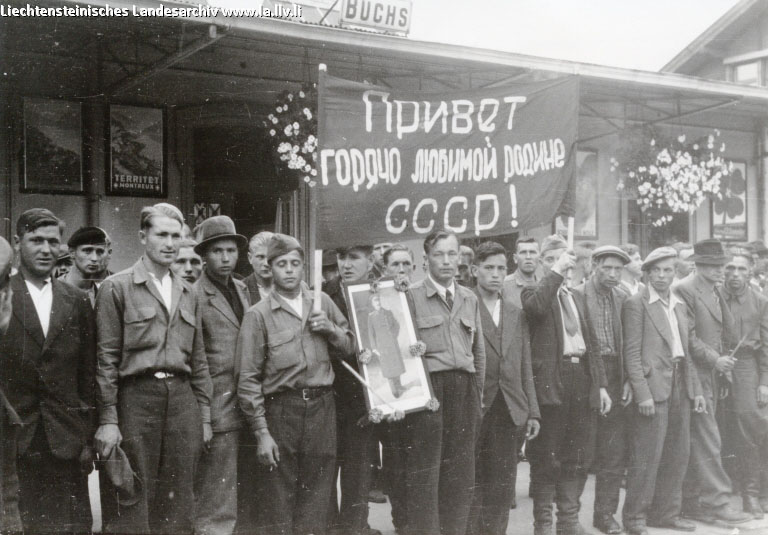 Farewell to 250 interned members of the "Russian National Army" at Buchs railroad station, August 1945
Farewell to 250 interned members of the "Russian National Army" at Buchs railroad station, August 1945
Liechtensteinisches Landesarchiv, B 413_002_101
38 End of the war
Mass rush at the Liechtenstein border in the last days of the war
Tisis-Schaanwald, Nofels-Oberfresch, April 25 to May 2, 1945
In the last few days of the war, thousands of “foreign workers”, prisoners of war and forced laborers held in Vorarlberg try to escape – or are pushed over the border to get rid of them. On April 22, the Swiss Federal Council closes the eastern border. Only two crossings remain open. In addition to St. Margrethen, the border crossing from Feldkirch to Liechtenstein between Tisis and Schaanwald now becomes the eye of the needle for people trying to reach safety in the chaos of the last days of the war.
Between April 25 and May 2, 7,370 people crossed the border here alone, among them 3,424 French, 1234 Russians, 759 Poles, about 300 Dutch, and some Greeks and Italians. But also 156 Swiss and 123 Liechtensteiner flee from the approaching war. The largest number of people, almost 3,000, arrive at the Liechtenstein border on May 2. On this day, French units, which had taken Bregenz the day before, fight their way through Hohenems and Götzis in the direction of Feldkirch.
At the Tisis border crossing, crowds of people jam together, break through the barriers and now stand in front of the Swiss border guards. But the Swiss insist on checks. Among the fugitives are also undesirables, members of the Vichy government and Vorarlberg National Socialists, in whose cars larger assets are suspected.[1]
The short-term care of thousands of refugees is new territory for the Principality of Liechtenstein. In previous years, the government granted asylum to only a few people. Some Jewish refugees from the German Reich had been accepted if they had sufficient funds and guaranteed job creation through their economic activities. In addition, the principality had issued passports against payment to some persecuted Jews who tried to flee the German Reich to other countries. However, they did so only on condition that they would not make use of them to emigrate to Liechtenstein themselves.
Spontaneous support from individual Liechtenstein citizens and organized illegal escape assistance from smugglers in Feldkirch and Liechtenstein, however, made it possible for some Jewish refugees to get through Liechtenstein to Switzerland in 1938 and 39.
Some of them were picked up by the cantonal police in Buchs and sent back to the German Reich.
But now, at the end of the war, the events come thick and fast, and the images of helping scouts and Princess Gina rushing to the border are imprinted in the memory.
In the night of May 2 to 3, there is also another mass rush at the small border post Oberfresch between Nofels and Schellenberg. These are members of the so-called “Russian National Army” who fought against the Soviet Union under the command of the German Wehrmacht - and now seek safety from the Allies. In the last days of the war, the remnants of this army, a convoy of 494 people, including 33 women and 2 children, reach the border at Nofels. They fear that they will be forcibly sent back to the Soviet Union.
Paul Keel, border guard at this post, later recalls:
“And there was a gate here in 1945 in May, with barbed wire, and in the night when the Russians came, about 11:30 p.m., the gate was opened for them and then they ran up, in the direction of Schellenberg. They had horses and wagons, children and strangers with them, who did not belong to the actual troops, under General Holmston. (...)
Two of our comrades kept watch there, and when the Russians drove up, the first ones in cars, the ones in the rear on foot, they - they did not react to calls from the guard, and then Corporal Morff fired a shot at the first car. Then they kept still, and the adjudant got out and said ‘please don't shoot, the general is sitting in the next car’. On the basis of this, they then ceased firing, and the entire convoy then moved on up to, shortly after the Lion inn, they then surrendered their weapons.”[2]
The Russians were initially interned in Liechtenstein. But the principality government wants to get rid of them as soon as possible. And pressure is exerted by the Soviet Union. The majority of the Russians actually return to the Soviet Union in the summer, partly via the intermediate station of French internment in Vorarlberg. A Soviet repatriation commission gives them assurances. But most of them are sent to prison camps in their homeland.
About 130 of them, including their general, Count Boris Smyslovsky, alias Arthur Holmston, successfully refuse and are eventually not extradited either. They emigrate to other Western countries, especially Argentina.[3]
[1] See Ursina Jud, Liechtenstein und die Flüchtlinge zur Zeit des Nationalsozialismus : innen- und aussenpolitische Dimensionen der Flüchtlingspolitik eines Kleinstaates. Dissertation, Zurich 2007, p. 106-107. (https://www.zora.uzh.ch/id/eprint/163655/1/20080219.pdf, 12.3.2022)
[3] Peter Geiger, „Russische Nationalarmee“, entry in: Historisches Lexikon des Fürstentum Liechtenstein online (https://historisches-lexikon.li/Russische_Nationalarmee, 12.3.2022)


